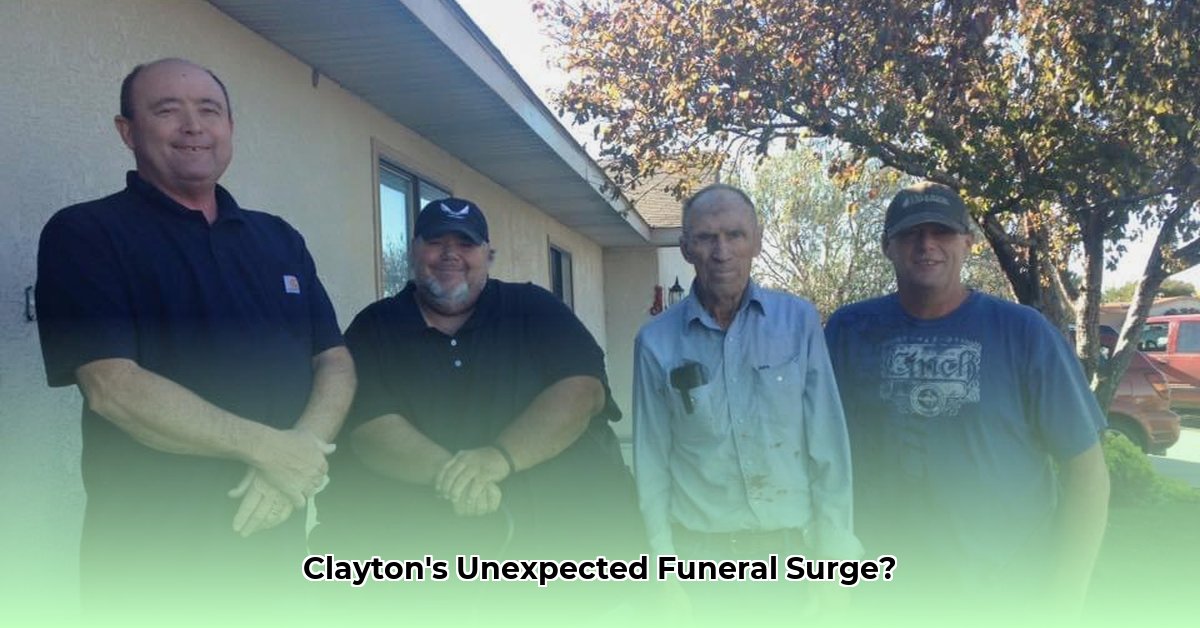
Understanding Recent Mortality Trends in Clayton, NM
Over the period December 2024 to March 2025, Clayton, NM experienced a notable increase in reported deaths, prompting an analysis of the situation's impact on Hass Funeral Home and the wider community. While initial data from Hass Funeral Home suggests at least 20 deaths during this timeframe, crucial details, such as the causes of death, remain unavailable. This lack of complete data significantly limits the ability to draw definitive conclusions about the underlying causes of this increase. Further investigation is required to understand the full significance of these findings. For further examples of funeral home data analysis, see this resource.
Analysis of Available Data: Limitations and Potential Interpretations
Available data indicates a potential concentration of deaths in late January and early March. However, comparing these figures to historical Clayton mortality rates is currently impossible due to a lack of comparative data. The absence of information regarding the types of funeral services chosen (cremation, traditional burial, memorial service, etc.) further restricts our analysis. This information would provide valuable insights for Hass Funeral Home's future planning and resource allocation. The wide age range of the deceased, encompassing both younger and older individuals, highlights the broad community impact of this recent increase.
Stakeholder Impact: Short-Term and Long-Term Consequences
The increased mortality rate has far-reaching consequences for various stakeholders in Clayton:
| Stakeholder | Short-Term Impacts (Next Year) | Long-Term Impacts (The Next Few Years) |
|---|---|---|
| Hass Funeral Home Clayton | Increased workload, potential staffing shortages, potential supply chain issues. | Enhanced data analysis capabilities for demand forecasting, potential facility expansion. |
| Union County Health Department | Increased workload investigating potential infectious disease outbreaks or environmental factors. | Improved disease surveillance and community preparedness for future health crises. |
| Community Organizations | Increased demand for grief counseling and community support services. | Development of long-term mental health support programs and resources. |
| Researchers/Epidemiologists | Increased demand for investigation into potential causes of death spike. | Long-term research to identify trends and patterns in mortality rates. |
Critical Need for Comprehensive Data: Addressing the Knowledge Gap
The most significant limitation of this initial analysis is the lack of detailed information regarding the causes of death. Without this critical information, any conclusions drawn remain speculative. Was this an unusual spike in mortality, a localized health crisis, or another factor entirely? The current data only provides a partial picture; a thorough investigation is urgently needed to determine the underlying causes and to avoid future crises. Access to complete death records, including age, location, cause of death, and type of funeral service, is essential to achieve this goal and for effective long-term community planning.
Actionable Steps: A Path Forward for Improved Data Collection and Analysis
To understand Clayton's recent mortality patterns, a systematic approach to data collection and analysis is imperative. It is a high-priority need to secure access to comprehensive data. This improved data will inform future planning and facilitate better responses to potential health emergencies.
Step-by-Step Guide to Improving Mortality Data Analysis for Hass Funeral Home:
- Data Acquisition: Secure access to complete death records from all relevant sources (Union County Health Department, etc.). (This step is critical for accurate analysis.)
- Data Cleaning and Verification: Thoroughly clean and validate collected data to ensure accuracy and consistency. (This enhances reliability and precision of the analysis.)
- Trend Analysis: Identify temporal patterns and potential outliers in the mortality data. (This helps identify periods of high mortality.)
- Demographic Analysis: Explore correlations between mortality rates and demographic factors (age, gender, location). (This provides insights into at-risk populations.)
- Cause of Death Analysis: Conduct a detailed analysis of causes of death to identify trends and potential health concerns. (This is crucial for targeted public health interventions.)
- Service Optimization: Use the insights gained from the analysis to optimize funeral services and resource allocation. (This optimizes services for the community.)
- Continuous Monitoring: Establish a system for ongoing monitoring and analysis of mortality data to facilitate early detection of potential future trends and crises. (This ensures ongoing preparedness.)
By implementing these steps, Hass Funeral Home and Clayton can move towards a data-driven approach to mortality planning and response. This investment in data collection and analysis will ultimately improve community health outcomes and enhance the services provided by local organizations. This systematic, data-driven approach is key to ensuring Clayton's ongoing preparedness and response to future events.